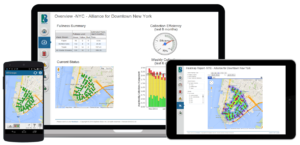Following on my train of thought on how the IoT is transforming products and business models, I took the opportunity to visit another IoT innovator during a recent trip to the Boston area. Their story is as insightful and thought provoking to those interested in IoT innovation as was my last example.
I suspect we all know of and have used the large dustbins (or trash collectors) often found in urban, highly populated areas; town centres, universities, corporate campuses etc. One might be excused for thinking that evolution in dustbins (and the way we collect from them) is pretty static. But to the contrary, a rapidly growing tech-savvy company, Bigbelly is actively transforming the ethos of urban waste management. And to a large part this transformation is IoT led.
So what’s the transformation? What can one do with a public space waste container or ‘dustbin’ that sets it apart from its peers. Maybe a more rugged possibly eco-friendly form. A novel aesthetic design perhaps? Well Bigbelly, founded in 2003, has long been on a roadmap to smart waste and recycling. First off they looked at the problem. In their own words, “Cities were either collecting too often and wasting fuel and labor while creating CO2 emissions or they were not able to keep up with the demands and overflowing trash cans created litter, health and safety issues.”
Their first innovation was their development of a clever dustbin that could compact its contents; and they used solar (i.e. zero cost) power to drive the compaction process. That meant the dustbin could collect more content before it needed to be emptied, resulting in significant savings (and CO2 emissions) in bin collections. These products were sold and installed, and Bigbelly customers immediately benefitted from increased capacity, reduced collections, and cleaner streets and sidewalks.
On to their next innovation. Their clever dustbins already had a power source (solar powered) and electronics. So what more could they do to improve their value to the customer? The answer was to add mobile communications via cellular networking so that these stations could ‘talk’ to the Cloud. This made their dustbins even more intelligent ….and better yet, connected. Linked to their web-based Cloud platform, Bigbelly was now able to offer their customers a system that could manage their waste collection operations. Customers learned to collect their dustbins on-demand, as opposed to on-schedule. This evolution delivered even more (significant) cost savings, less CO2 from collection vehicles, improved uptime and better hygiene regimes. In parallel, Bigbelly redefined their business model. They packaged physical product together with their Cloud based management and monitoring software and now offer this platform as a subscription service. A novel proposition, but one that’s becoming much more common in today’s IoT ecosystem.
Bigbelly’s innovations have made them an intrinsic part of the Smart City initiatives of many of their clients. Per Jack Kutner, their CEO, “we actually were a Smart City app before Smart Cities arrived”. With over 30,000 units installed in over 50 countries, growth has been impressive by anyone’s standards. As with all pioneering companies they do face challenges. Not least of these is a degree of resistance to what is a radically new business model. I’ve met with a couple of their (council) customers and they rave about the value proposition. But as we all know; change is not always easy (or obvious).
we all know; change is not always easy (or obvious).
So what’s next for Bigbelly? For one they have a vision of development that moves their product well beyond that of ‘Smart Waste’. Their products are situated in areas of ‘prime real estate’, in populated areas. That means that, should customers need it, they could perhaps add additional sensors, for footfall measurement, weather etc.…. perhaps WiFi? In fact, their mid-term vision is to become a platform of shared infrastructure for their clients. To help move this forward they’re opening their Cloud platform and developing an API on which their customers can build some pretty exciting new apps.
Personally, I think that this is a great example of a company that’s moving beyond the traditional and taking advantage of technology, and the IoT, to differentiate themselves well beyond their traditional competitors. I hope you agree?
By the way, If you know of other companies that you think are particularly worthy and IoT innovative, feel free to let me know and I’ll investigate for a future post…
